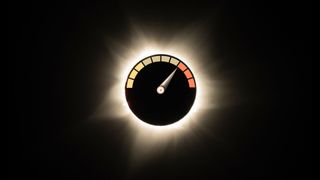
The solar eclipse on April 8 with travel at varying speeds.
(Image credit: Daisy Dobrijevic/Canva)
When the moon’s shadow races across Earth on April 8 during the total solar eclipse, it will travel faster than the speed of sound.
It will sweep across Earth at more than 1,500 miles (2,400 kilometers) per hour on April 8, according to NASA.
However, exactly how fast it will move where you are will depend on where you are.
Related: Total solar eclipse 2024: Everything you need to know
Understanding the moon’s shadow
A solar eclipse occurs on Earth when a new moon blocks at least part of the sun, as seen from Earth. All solar eclipses project a large fuzzy shadow onto Earth called the penumbra. From within it, observers see a partial solar eclipse, watching the moon gradually block some of the sun before gradually moving away.
Only during a total solar eclipse, when the moon blocks all of the sun, does a smaller, darker conical shadow called the umbra project onto Earth. This is the path of totality, and from within it, observers see partial phases on either side of a total solar eclipse.
Distance and speed of the moon
The umbra passes over Earth during the total eclipse on Monday, August 21, 2017. (Image credit: NASA Johnson/Flickr)
The width of the umbra (the path of totality) and the penumbra (the partial eclipse zone) depend on the moon’s distance from Earth during the eclipse. This also affects the speed at which the shadow moves, as does the rotational speed of the moon and the Earth. The moon is orbiting Earth from west to east, the same way Earth rotates, but the moon moves more quickly.
Breaking space news, the latest updates on rocket launches, skywatching events and more!
The penumbral and umbral shadows of the moon are projected as a path because Earth rotates under the faster-moving shadow of the moon. So, although the moon’s shadow moves across Earth very quickly during an eclipse, it’s counteracted by the Earth’s rotational speed.
Why it slows down and speeds up
Although the moon’s shadow would move even more quickly across the planet if it weren’t rotating, on April 8, that shadow will still move exceptionally fast. However, it won’t travel at a consistent speed.
“The moon’s shadow will travel slowest at the point of greatest eclipse near the town of Nazas, Mexico, where the duration is longest and also where the shadow speed is the lowest,” said Michael Zeiler, eclipse cartographer at GreatAmericanEclipse.com. “As the shadow progresses across North America, the shadow speed increases because the oblique angle of the shadow on a curved Earth results in a higher ground speed.”
For example, at 11:37 UT on April 8, the event will begin as an eclipsed sunrise in the Pacific Ocean, during which the moon’s shadow will be traveling at a whopping 10,439,792 mph (16,801,217 kph), according to eclipse expert Xavier Jubier’s Interactive Google Map of the eclipse.
As it ends as an eclipsed sunset in the Atlantic, it will be traveling at 5,535,176 mph (8,908,002 kph). However, close to Nazas, Mexico — the point of the greatest eclipse where the centers of the sun, moon, and Earth are in perfect synergy (alignment) — it will be moving at a pedestrian 1,565 mph (2,519 kph). The shadow will slow down to that point and speed up after, so as the moon’s shadow enters the U.S. in Texas, it will speed up slightly to 1,597 mph (2,570 kph). It will then pick up the pace across the U.S. and, as it leaves Newfoundland in Canada for the Atlantic, it will be moving at 4,727 mph (7,607 kph).
April’s total solar eclipse will travel at speeds ranging from 10 million miles an hour — half the speed of the fastest supernova explosion ever detected — to as slow as 1,565 mph, about twice the speed of a supersonic aircraft. Just ensure you’re inside the path of totality to stand beneath it!
Join our Space Forums to keep talking space on the latest missions, night sky and more! And if you have a news tip, correction or comment, let us know at: community@space.com.
Jamie is an experienced science, technology and travel journalist and stargazer who writes about exploring the night sky, solar and lunar eclipses, moon-gazing, astro-travel, astronomy and space exploration. He is the editor of WhenIsTheNextEclipse.com and author of A Stargazing Program For Beginners, and is a senior contributor at Forbes. His special skill is turning tech-babble into plain English.
>>> Read full article>>>
Copyright for syndicated content belongs to the linked Source : Space.com – https://www.space.com/how-fast-will-total-solar-eclipse-2024-travel
